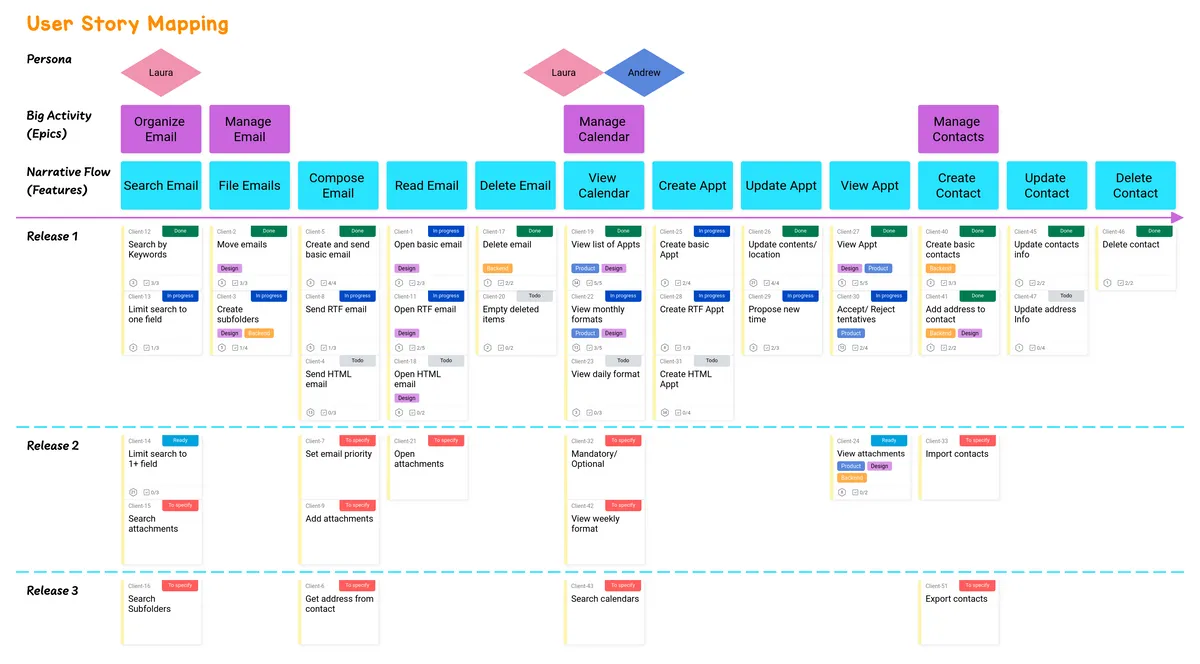What is User Story Mapping?
The primary goal of User Story Mapping is to deliver greater value to end users by building less. It may seem contradictory to say this, but that’s exactly what this exercise is all about.
Popularized by Jeff Patton, User Story Mapping facilitates collaboration between business owners and development teams in order to help them build the right products in the right order. The power and efficiency of User Story Mapping have become popular with Agile teams as a go-to method for prioritizing their backlog.
To get started with User Story Mapping, you need to first put yourself in your users’ shoes. This is the best way to build the narrative flow as it relates to how an actual user might navigate the eventual product experience. Be sure to detail each step in chronological order, if possible. This will become the backbone of your User Story Map, which is made up of big user stories called ‘epics.’
Once you’ve created this foundation, you need to determine the individual user stories allowing users to reach their desired outcomes successfully via your product. Start by asking yourself, “Why would someone use this product in the first place?” More often than not, this will trigger conversations between business owners and development teams to build a shared understanding around key business, product, and technical issues.
Finally, you need to put all of these user stories into hierarchical order (arranged vertically) to determine the minimum number of tasks and product features that would bring the most basic level of value to end users. This is called a Minimum Viable Product (MVP), an early version of a product designed specifically to elicit user feedback to inform future product iterations. You can do this multiple times, creating a second and a third version of the product, before establishing the optimal end user product experience.
What is an MVP?
One of the most common misconceptions about MVPs is that they should function correctly from a technical perspective the first time around. But that’s not exactly accurate. Let’s use an analogy to explain this. In nature, the term ‘viable’ refers to a living organism that can survive on its own in its own environment. The concept of an MVP follows the same premise.
Simply put, an MVP is the smallest product release that both enables users to achieve their desired (and most basic) outcomes while also fueling your Agile process by giving them an opportunity to weigh in with feedback about what they expect from your product in the future.
Some tips from Jeff Patton himself
In an interview with Jeff Patton in April 2020, he provided a first-hand take on his approach to User Story Mapping. These were the main takeaways:
- It’s like a movie screenplay. You write your users’ scenarios through the lens of the adventure your product creates.
- It’s a “living” tool for deep reflection. It’s not meant to be “one and done.” Don’t hesitate to throw it out and build a new one from scratch, especially as user needs change.
- It’s imprecise and incomplete by nature. Don’t try to be exhaustive or allow yourself to be caught up in every minute detail.
- It’s both a common visual representation of the product experience and a portal towards other parts of the product development system. This is what makes User Story Mapping so powerful.
- It is an artifact that grows organically. You can’t predict a product’s final structure right from the start; you naturally find the right structure as you go through this iterative process.
Some other tips from Product Management professionals
Fatima-Zahra Hamil, Head of Advisory and Training at Wivoo, underscores three critical steps for running successful User Story Mapping sessions:
- Refine your product vision to align closely to underlying market issues and current user problems.
- Explicitly set the project’s goals right from the start (monetization, audience, etc.), as this will have a direct impact on the MVP’s feature scope.
- Agree upon your Persona. This will make it easier to identify the exact features that will deliver the greatest value to your end users.
Following a productive User Story Mapping session, you should have all the elements to build your Product Roadmap.
Suggested resources to master User Story Mapping further
- Essential Jeff Pathon’s website: jpattonassociates.com/user-story-mapping/.
- Judicaël Paquet’s didactic blog article: User Story Mapping - Example.
- UXClub.com’s popular video: How to do User Story Mapping.
